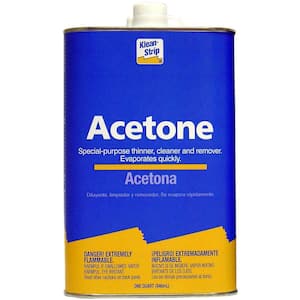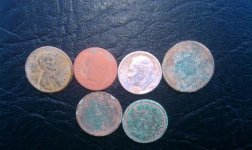KeyLargo
Junior Member
I see alot of different ways to clean coins on this forum, most I would not recommend. There are several ways to clean coins and there are a couple that will not destroy your coin. I am going to show everyone a simple easy way to clean your finds that will not destroy the coins.
Step 1.
Head to your local home depot or lowes and pick up some acetone.

This type of acetone is pretty strong however for a more pure form of acetone purchase technical grade acetone or reagent grade acetone, both found online and are affordable.
Acetone will remove organic and many man-made contaminants from a coin's surface. The primary purpose of Acetone is as a paint thinner/remover, because it breaks down the rubbery and other compounds within paint. Acetone will remove PVC from a coin's surface, that is the main use when dealing with coins. It will also remove tape residue, and a lot of other miscellaneous "gunk" from coin's surfaces. It's also good for removing fingerprints.
Step 2.
You will also need a glass container that can be sealed. I strongly recommend canning jars - the small/short kind, not the ones you cannot get your hands into. The container should definitely be glass as Acetone will attack and break down other materials, eating a hole in the side and leaking out. You should also not wear gloves when dealing with acetone - again, they will break down.
Step 3.
You will also need an area which is well ventilated to work in - outside is best, if that is not possible, in a garage would be second-best. I do not recommend working indoors as acetone evaporates extremely rapidly and is very hazardous if inhaled in sufficient quantity. Keep it well away from grills, smokers, or anything similar as it's very flammable. Keep it away from other liquids such as gasoline. Stay away from grass, plants, etc. as well as it could damage them.
Now that you have the stuff you need and an area in which to work, here is what you do:
Step 4.
• Place the container (canning jar) in the location that the coin will rest. Because you're working with a glass jar and the coin will be in it, you don't want to move the jar once the coin is inside, as you could damage the coin by allowing it to slide around the bottom of the jar.
Step 5.
• Pour a generous amount of acetone in the jar, fill it halfway or 3/4ths of the way up.
Step 6.
• Carefully place the coin inside the acetone jar and screw the lid tightly onto the jar. You will have to seal it up, or the acetone will evaporate away. Close the acetone container right way as well.
Step 7.
• Allow the coin to soak in the acetone. Anywhere from 5 minutes to 2 days, until the stuff evaporates off of the coin. Acetone will not attack the coin's metals in any way so you don't have to worry about overdipping the coin - the lustre and toning will be unimpared, even after extended periods of soaking. The length of time you need to soak the coin will vary with the specific amount and type of contaminants you need to remove.
Step 8.
• Remove the coin and examine it to be sure the acetone has dissolved everything. If you're satisfied,rinse the coin with distilled water, pat dry.
Step 9.
• To discard the acetone afterward, pour it on a concrete or paved surface outside. It will simply evaporate away. Some of the comtaminants may remain inside the container, so rinse it out thoroughly.
The method described above is generally used on coins that would have a numismatic value. If you happen to dig a rare key date coin you could use this method without damaging the coin. Several coins graded by major grading companys have been dipped.
Here is an example of the above method.


You can also use the above method on clad coins that are dug as well but have no numismatic value. With clad coins you dont need to be so careful, just place a bunch in a jar, shake it up let sit and follow the rest of the steps.
Step 1.
Head to your local home depot or lowes and pick up some acetone.

This type of acetone is pretty strong however for a more pure form of acetone purchase technical grade acetone or reagent grade acetone, both found online and are affordable.
Acetone will remove organic and many man-made contaminants from a coin's surface. The primary purpose of Acetone is as a paint thinner/remover, because it breaks down the rubbery and other compounds within paint. Acetone will remove PVC from a coin's surface, that is the main use when dealing with coins. It will also remove tape residue, and a lot of other miscellaneous "gunk" from coin's surfaces. It's also good for removing fingerprints.
Step 2.
You will also need a glass container that can be sealed. I strongly recommend canning jars - the small/short kind, not the ones you cannot get your hands into. The container should definitely be glass as Acetone will attack and break down other materials, eating a hole in the side and leaking out. You should also not wear gloves when dealing with acetone - again, they will break down.
Step 3.
You will also need an area which is well ventilated to work in - outside is best, if that is not possible, in a garage would be second-best. I do not recommend working indoors as acetone evaporates extremely rapidly and is very hazardous if inhaled in sufficient quantity. Keep it well away from grills, smokers, or anything similar as it's very flammable. Keep it away from other liquids such as gasoline. Stay away from grass, plants, etc. as well as it could damage them.
Now that you have the stuff you need and an area in which to work, here is what you do:
Step 4.
• Place the container (canning jar) in the location that the coin will rest. Because you're working with a glass jar and the coin will be in it, you don't want to move the jar once the coin is inside, as you could damage the coin by allowing it to slide around the bottom of the jar.
Step 5.
• Pour a generous amount of acetone in the jar, fill it halfway or 3/4ths of the way up.
Step 6.
• Carefully place the coin inside the acetone jar and screw the lid tightly onto the jar. You will have to seal it up, or the acetone will evaporate away. Close the acetone container right way as well.
Step 7.
• Allow the coin to soak in the acetone. Anywhere from 5 minutes to 2 days, until the stuff evaporates off of the coin. Acetone will not attack the coin's metals in any way so you don't have to worry about overdipping the coin - the lustre and toning will be unimpared, even after extended periods of soaking. The length of time you need to soak the coin will vary with the specific amount and type of contaminants you need to remove.
Step 8.
• Remove the coin and examine it to be sure the acetone has dissolved everything. If you're satisfied,rinse the coin with distilled water, pat dry.
Step 9.
• To discard the acetone afterward, pour it on a concrete or paved surface outside. It will simply evaporate away. Some of the comtaminants may remain inside the container, so rinse it out thoroughly.
The method described above is generally used on coins that would have a numismatic value. If you happen to dig a rare key date coin you could use this method without damaging the coin. Several coins graded by major grading companys have been dipped.
Here is an example of the above method.


You can also use the above method on clad coins that are dug as well but have no numismatic value. With clad coins you dont need to be so careful, just place a bunch in a jar, shake it up let sit and follow the rest of the steps.




 Most of the coins you posted are beyond a cleaning.
Most of the coins you posted are beyond a cleaning.